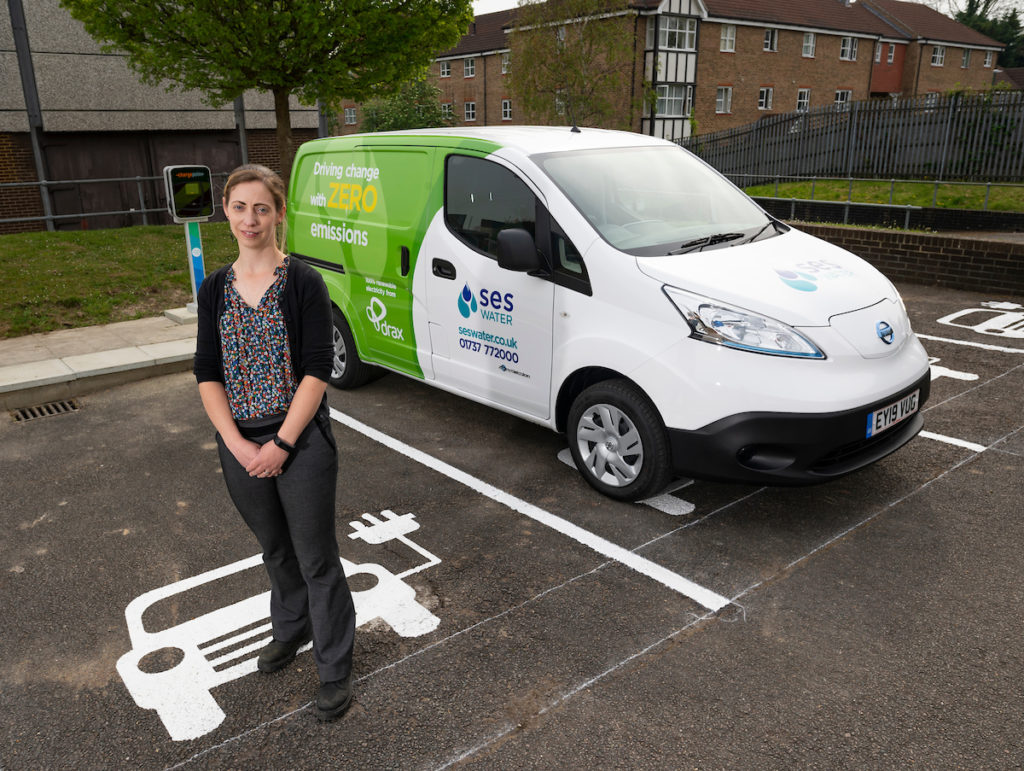
SES Water has been trialling EVs ahead of a wholesale switch. Energy and carbon manager, Henrietta Stock, says there are potholes to navigate, but the experience has largely been positive.
SES Water started trialling EVs last year, initially with 10 vehicles (around 8 per cent of the fleet). It has since added another handful, and has installed around 30 charge points. More vehicles and chargers will follow over the coming months.
“The trial has put us in a really good place,” says energy and carbon manager, Henrietta Stock. “Fleet is a key aspect of decarbonisation and we’re in a stronger position because we have started the process and gained some learning.”
Stock says SES Water started with the “straightforward cases, drivers that don’t cover a huge amount of distance or who might spend a reasonable amount of time at a particular site where they can charge the vehicle,” she explains.
“Over time, we worked up to the more challenging profiles, which gave us a good view of the challenges posed for different types of drivers.”
Charging speeds are an issue. “For us, that is a vehicle limitation rather than a charging limitation,” says Stock. “The [Nissan] eNV-200s are limited to 7kW charging speeds, whereas the chargepoints we have installed are 22kW. So for now, that is a bit of a limitation and a bit of a challenge. People have to adjust and schedule around that, which becomes increasingly complex as you roll out more vehicles.”
Driver influence
Drivers, however, “really like the vehicles, even those initially sceptical are converts,” says Stock. “There tends to be some uncertainty – but only until they have tried them.”
Meanwhile, telematics and chargepoint data has underlined the impact of driving style on range. “Our least-efficient driver gets about 70 miles fewer than the most-efficient, which is significant given range is about 140 miles,” says Stock. “So they are having to charge twice as often – they find that quite inconvenient and it starts to have a real operational impact.”
As such, SES and its EV partner Haven Power are working on driver education programmes in order to maximise range.
Emissions anxiety: Public charge points
As the trial broadened to drivers doing higher miles, SES found they needed to use public charging facilities more than it had anticipated.
“We’re trying to address that. It can be very expensive. The payment methods are disparate and the drivers have to reclaim the charge,” says Stock.
“We also have concerns around emissions, because our electricity source is 100 per cent renewables. Externally, we don’t have that guarantee.”
While SES has not yet installed home chargers for its EV drivers, doing so will ultimately pose similar questions.
In the meantime, Stock hopes smart fuel card solutions come to market.
“There are companies developing cards that can be used across networks and that report the greenhouse gas emissions associated with the electricity from different charge points. That is the kind of solution we need,” she says. “We have reasonably good coverage at our sites and most of the time we can charge at our own locations. But that kind of solution would be really helpful.”
Car policy challenge
Around a third of the SES fleet is made up of company cars and historically all vehicles have been purchased. While Benefit in Kind changes make EVs more attractive, to date there has been limited ability to bring in EVs – because staff allowances have not been adjusted to meet their higher price points.
“There are a number of things we are working through. What’s great is that, because of the work we have done introducing EVs to the commercial vehicle fleet, drivers are more aware of the options and keen to make use of the charging infrastructure we now have in place,” says Stock.
“The company car drivers themselves have really moved the debate forward and we’ve recently committed to making all new company cars EVs or PHEVs. This is in addition to our existing commitment that all new commercial fleet vehicles will be EVs or PHEVs where viable technology exists.”
Watts in a name…
Stock isn’t kidding when she says the company has become attached to its vehicles, and vans in particular. Its 11 Nissan eNV-200s have been christened by staff. Despite in-depth interviews and a survey of more than 300 businesses, the following roll of honour is likely to be the most shared aspect of the 2020 EV report on social media. For the record, SES Water’s vans are called:
Mo Farah Day | Emma Wattson | Usain Volt | Sherlock Ohms| Carmen Electron | Charge Simpson | Elecy Simmonds | Spark Zuckerberg | Joules Holland | Gillian Amperson and … Dane Powers
Free download: The 2020 EV report
 This article is one of a number of in-depth interviews conducted for The Energyst’s new 2020 EV report. It contains expert insight across a range of sectors, plus a survey of more than 300 firms around EV charging infrastructure plans.
This article is one of a number of in-depth interviews conducted for The Energyst’s new 2020 EV report. It contains expert insight across a range of sectors, plus a survey of more than 300 firms around EV charging infrastructure plans.
Sponsored by Arup, EDF, Good Energy, New Motion and Total Gas & Power, the report also includes views from: Arval, Cenex, DPD, Dreev, Engenie, ev.energy, Hitachi Capital Vehicle Solutions, Mitie, National Grid, Nottingham City Council, the John Lewis Partnership, TLT, UPS, UK Power Networks and Western Power Distribution. Download the report here.



